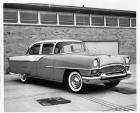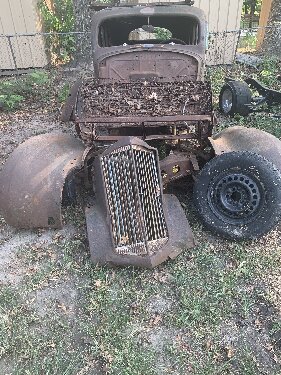|
Re: Specific treadle-vac problem
|
||||
|---|---|---|---|---|
|
Home away from home
|
Craig,
Thanks for your answer. Tom
Posted on: 2013/6/19 14:15
|
|||
|
||||
|
Re: Specific treadle-vac problem
|
||||
|---|---|---|---|---|
|
Home away from home
|
Bhappy
If you do that you may need adapters. ALK
Posted on: 2013/6/19 16:53
|
|||
|
Al
1955 Patrician |
||||
|
||||
|
Re: Specific treadle-vac problem
|
||||
|---|---|---|---|---|
|
Home away from home

|
AL - all joking aside, I am one who experienced a catastrophic brake failure with the BTV on my 56 Executive. I eventually installed a modern MC/booster as per Craig's instructions. The process was easy except for the brake pedal build. It was done in a way that I can easily revert back to the original BTV if I ever get the mindset to do so (after almost 4 years, I don't think that I will).
My experience was while DRIVING with NO INDICATION OF BTV FAILURE WHILE THE CAR WAS STILL. If I had any inclination that there was a problem with my brakes while the car was still, I would've never driven it until I repaired the problem. I thought about repairing the BTV, but I just couldn't see spending good money after bad. I know that with the BTV out of the picture, my brakes will work, each time I push the pedal. That is why I recommend getting rid of the BTV. Besides, I can now see my brake fluid level in the remote fluid reservoir. It was more expensive to do the install than just having my BTV rebuilt, but I know I won't have to go through the expense again on this car. If you decide to remain with the BTV, there will always be the doubt lingering of "WHAT DO I DO IF I PRESS ON THE BRAKE PEDAL AND MY BRAKES DON"T WORK"! It's a simple matter of TRUST.
Posted on: 2013/6/20 5:24
|
|||
|
Bob
IF EVERYTHING IS COMING YOUR WAY ... - - - - - - - - - - - - - - - - - - - - - - - - YOU'RE IN THE WRONG LANE! '56 Executive Touring Sedan |
||||
|
||||
|
Re: Specific treadle-vac problem
|
||||
|---|---|---|---|---|
|
Home away from home
|
Has anyone ever figured out why this happens? From all of the discussion, it seems no one has, they have just done the conversion. I for one would like to know why.
ALK
Posted on: 2013/6/20 6:14
|
|||
|
Al
1955 Patrician |
||||
|
||||
|
Re: Specific treadle-vac problem
|
||||
|---|---|---|---|---|
|
Home away from home
|
I think it's a bit odd that so few, if any, that have had a BTV-failure, have done a post-mortem on the unit.
I, for one, should only check the brake fluid reservoir, a while after I bought my Clipper in 2010.(As mentioned in my post of 2012/10/28) And boy am I glad I did; nearly empty reservoir with some rust lumps. When checking more; 2 leaking wheel cylinders, vacuum cylinder rusted and filled with "rusted" brake fluid, rust pitted brake piston, leaking seal, broken brake shoe linings rear end, and of course the culprit; the reservoir lid gasket that covered the return hole. In addition the brakes had not been bled for years. I replaced the lines,the brake shoes,wheel cylinders and installed a rebuilt BTV. Later on I have asked several owners of old cars, how often they bled their brakes, and shockingly many just stared at me. They did not do anything! Perhaps they checked the level now and then. Malfunction of the brakes therefore does not surprise me. If you don't bleed your brakes every 2 year, I think you are taking chanses.  Tom
Posted on: 2013/6/20 7:11
|
|||
|
||||
|
Re: Specific treadle-vac problem
|
||||
|---|---|---|---|---|
|
Home away from home
|
Will go with Tom on this one. With a regular change of fluid the brake systems seem to hold up about indefinitely. Treadlevacs, because of the compensator valve, will not tolerate lumpy dirty fluid that is halfway turned to a solid. I have never seen a unit that suddenly lost all its fluid into the vacuum section, but I have seen many with reservoirs half filled with ancient fluid that has turned into something like vermiculite.
Posted on: 2013/6/20 12:05
|
|||
|
||||
|
Re: Specific treadle-vac problem
|
||||
|---|---|---|---|---|
|
Just can't stay away

|
Back to the question at hand, what could be the problem. When I accquired my 55 400, it had sat for 3 or 4 years prior. The brakes worked, but not properly. The pedal was very hard but would gradually depress and stop the car. I discovered the flexable rubber brake hoses had swelled shut internally and would only allow the fluid to flow very slowly. Once I replaced the flexable rubber brake hoses everything worked great. Almost put me through the windshield with the first application. I also replaced all 4 wheel cylinders while I was at it. You might try disconnecting a rubber brake hose from the steel line and depressing the pedal. If your pedal goes to the floor then you have the same problem I did, collapsed rubber brake hoses. Hope this helps. Brian
Posted on: 2013/6/21 0:16
|
|||
|
||||
|
Re: Specific treadle-vac problem
|
||||
|---|---|---|---|---|
|
Home away from home
|
Brian:
I will look into that. Is there any way to check that out with the T/V unit out of that car. I would hate to have to put it all back together again without a solution. However I would hate to re-build the T/V unit if it did not need it. ALK
Posted on: 2013/6/21 5:48
|
|||
|
Al
1955 Patrician |
||||
|
||||
|
Re: Specific treadle-vac problem
|
||||
|---|---|---|---|---|
|
Forum Ambassador

|
Sorry, no advice for what you might do with the unit off the car, but there are a couple of elementary tests one can do with the unit on the car to test the vacuum portion of the unit.
Run the engine. Shut it off and then repetitively press on the brake pedal and release. On each stroke you are consuming some of the vacuum reserve so each time the pedal should have less motion and become "harder" and after about 3 applications the vacuum reserve should be depeleted. If you don't observe this and the pedal is "hard" immediately, then you have a leak in the vacuum system. Usual culprits are hoses, leak in the reserve tank, or a defective vacuum check valve at the intake manifold. After doing the above, put your foot on the pedal with slight pressure and, holding your foot there, start the engine. The pedal should fall away a bit under your foot. If not, the vacuum booster is not functioning.
Posted on: 2013/6/21 8:31
|
|||
|
||||








